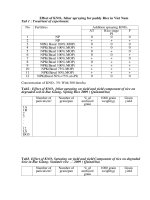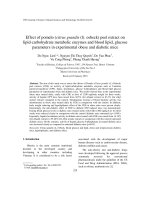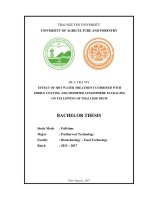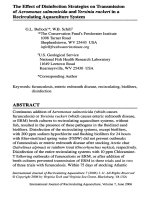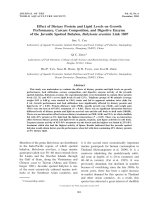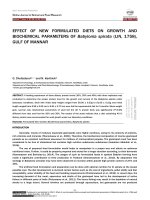Effect of culture media on shoot proliferation and callus induction of bael (Aegle marmelos L.)
Bạn đang xem bản rút gọn của tài liệu. Xem và tải ngay bản đầy đủ của tài liệu tại đây (252.38 KB, 6 trang )
Int.J.Curr.Microbiol.App.Sci (2020) 9(3): 243-248
International Journal of Current Microbiology and Applied Sciences
ISSN: 2319-7706 Volume 9 Number 3 (2020)
Journal homepage:
Original Research Article
/>
Effect of Culture Media on Shoot Proliferation and Callus Induction of
Bael (Aegle marmelos L.)
Pukh Raj, Mohan Lal Jakhar, Sarfraz Ahmad, Kassim Yahya Mtilimbanya,
Suman Chahar and Hari Ram Jat
Department of Plant Breeding and Genetics, S.K.N. Agriculture University,
Jobner, Rajasthan-303029, India
*Corresponding author
ABSTRACT
Keywords
Aegle marmelos,
Callus induction,
Micropropagation,
Murashige and
Skoog medium,
shoot proliferation,
Woody Plant
Medium.
Article Info
Accepted:
05 February 2020
Available Online:
10 March 2020
The present investigation was carried out at Tissue Culture Laboratory of S.K.N.
Agriculture University, Jobner, India during 2018-19. Experiment was laid out
using completely randomized design (CRD) with ten replications. Six culture
media viz. Murashige and Skoog media, Nitsch & Nitsch media, woody plant
medium, Schenk and Hildebrant medium, White’s medium and Khudson solution–
C were tested for direct shoot proliferation and callus induction at most responsive
level of plant growth regulators in Bael (Aegle marmelos L.). Highest shoot bud
induction (4.1) was observed using woody plant medium with 100 per cent
morphogenetic response using nodal segment explant along with BAP at 2 mg/l
concentration. Maximum callus induction on leaf explant was observed on
Murashige and Skoog medium with 40 per cent morphogenetic response followed
by woody plant medium (30 per cent) with 2,4-D at 2 mg/l concentration. Thus for
large scale micropropagation, woody plant medium using nodal segment explant is
recommended for shoot proliferation and for callus induction, MS medium taking
leaf as explant will be rewarding for mass multiplication of Bael.
most important tree species used in various
indigenous systems of medicine in India
(Kritikar and Basu, 1994).
Introduction
Bael (Aegle marmelos L.) is a subtropical
plant commonly known as Bengal quince,
Bilva, Indian quince, Golden apple, Holy
fruit, Bel, Belwa, Sriphal, Stone apple and
Maredo (John and Stevenson, 1979). It have
chromosome number 2n=18 in its genetic
composition and believe to originated in India
(Zeven and De Wet, 1982). Bael is one of the
Out of more than 66 ethno-botanical uses
of bael, 48 are exclusively for medicinal
purposes. Almost all parts of bael plant are
used in preparing medicine. Ayurveda
practitioners commonly use the roots
of bael as an ingredient of dasamula (ten
243
Int.J.Curr.Microbiol.App.Sci (2020) 9(3): 243-248
roots), which is useful in recovering the loss
of appetite and fruits are uses in the
preparation of chyavanprash. Ripe bael fruit is
sweet, aromatic and nutritive, whereas fresh
fruit is astringent and has laxative
properties. Bael fruit powder exhibits anticancerous and anti-proliferative activities. Its
wood is also suitable for making charcoal.
are used. Thus the present investigation has
been undertaken to see the effects of different
culture media on propagation of bael under in
vitro conditions to produce true to type and
virus free plants.
Materials and Methods
The present investigation was carried out at
Tissue Culture Laboratory of Department of
Plant Breeding and Genetics, S.K.N.
Agriculture University, Jobner, Rajasthan,
India during 2018-19. Nodal segment with 23 nodes and leaves were used as explants
which were collected from healthy tree
planted in department of horticulture.
Mercuric chloride (0.1 per cent) was used for
surface sterilization. Different media like
Murashige and Skoog, Nitsch & Nitsch,
Woody Plant Medium, Schenk and Hildebrant
Medium, White’s Medium and Khudson
Solution–C were tested for direct shoot
proliferation and callus induction at most
responsive level of plant growth regulators.
Bael is usually propagated by seeds and root
suckers though many problems are associated
with these methods. Due to all these
drawbacks, micropropagation methods alone
following tissue culture techniques can
provide some hope for rapid mass
multiplication and germplasm conservation of
this rare endangered medicinal tree, though
several limitations such as low shoot
proliferation, excessive phenolic exudation,
basal callusing, vitrification and shoot tip
necrosis come in its way (Vennel Raj et al.,
2012).
Propagation through tissue culture also
eliminates the possibility of any interruption
in the growing season because it can be
carried out inside a carefully regulated,
controlled environment (Lee et al., 2019). The
composition of growth medium is an
important factor affecting growth and
morphogenesis of plant tissues. Plant tissue
culture medium consists of macronutrients,
micronutrients, vitamins, amino acids or other
nitrogen supplements, carbon sources, organic
supplements, solidifying agents and growth
regulators.
For shoot bud induction in nodal segment
explant, BAP at 2 mg/l concentration and for
callus induction in leaf explant 2,4-D at 2
mg/l concentration were used in different
medium. All the cultures were maintained in
culture room at temperature of 25 ± 20C under
fluorescent light in a 14:10 hour’s
photoperiod. Cultures were thoroughly
observed at a periodicity of 7 days till 45th day
of each experiment.
The observations were recorded on days taken
for shoot bud initiation, number of shoots per
explant, morphogenetic response (per cent),
days taken for callus initiation, callus growth,
callus color and morphogenetic response of
callus (per cent). The experiment was
conducted in completely randomized design
(CRD) comprising ten replications and data
were analyzed for mean and standard error
accordingly as described by Snedecor and
Murashige and Skoog (MS) is the most
commonly used medium in plant tissue
culture. The B5 (Gamborg et al., 1968), N6
(Chu, 1978) and Nitsch and Nitsch (Nitsch
and Nitsch, 1969) have been widely used for
many plant species. Moreover, for culture of
woody species, the DKW (Driver and
Kuniyuki, 1984) and the Woody Plant
Medium (WPM) (Lloyd and McCown, 1980)
244
Int.J.Curr.Microbiol.App.Sci (2020) 9(3): 243-248
Cochran (1972). Test of significance was
done according to Duncan’s Multiple Range
Test (DMRT) for different traits (Gomez and
Gomez, 1984).
explants, different culture media were
supplemented with most responsive level of
BAP at 2.0 mg/l concentration. Highest shoot
bud induction (4.1) was observed using WPM
with 100 per cent morphogenetic response
(Table 1 and Fig 1) followed by Murashige
and Skoog medium (3.8) and Whites medium
(2.1). These results were in close agreement
with the observations of El-Agamy et al.
(2009) in pomegranate and Kumar (2018) in
pomegranate
cv.
Sindhuri
cultivars
propagation where WPM significantly
produce higher average number of nodes
followed by those grown on MS medium.
Results and Discussion
To see the effect of different culture media on
shoot proliferation and induction of callus six
types of culture media were studied.
Significant differences were observed in
different culture media for number of shoot
bud induction and morphogenetic response.
For shoot bud induction in nodal segment
Table.1 Effects of different media on shoot bud induction using BAP (2.0 mg/l)
in nodal segment explants of bael.
S.
No.
Media
1
Murashige and Skoog
Medium
Woody Plant Medium
White’s Medium
Schenk and Hildebrant
Medium
Nitsch and Nitsch Medium
Khudson Solution-C
2
3
4
5
6
Days taken
for shoot bud
initiation
13.9
Number of shoot bud
induced
Morphogenetic
response (%)
2.071* (3.8) a
100
13.5
18.6.
-
2.121* (4.1) a
1.532* (2.1) b
0.707* (-) c
100
80
-
20.3
-
1.496* (1.9) b
0.707* (-) c
60
-
(-) = No response;
(*) = Transformed value
() = Value in parenthesis represents mean number of shoot bud
Values followed by same letters in each column are not significantly different (p<0.05) using DMRT
For callus induction in leaf explant different
culture media were supplemented with most
responsive level of 2,4-D at 2.0 mg/l
concentration. Maximum callus induction was
observed on Murashige and Skoog medium
with 40 per cent morphogenetic response
(Table 2 and Fig 2) followed by Woody Plant
Medium (30 per cent) and Whites medium
(20 per cent). MS medium and WPM were
found ideal for induction of calli from leaf
explants also reported by Vasantha and
Shivanna (2005) in Desmodium oojeinense.
Callus induction did not exhibit on the Nitsch
and Nitsch, Schenk and Hildebrant medium
and Khudson Solution-C medium even in the
presence of plant growth regulators which
were responsive on other media.Thus for
large scale micropropagation of Bael (Aegle
marmelos L.) it is recommended to use
woody plant medium using nodal segment
explant for profuse shoot proliferation and for
high morphogenetic response to induce callus,
use of MS medium taking leaf as explant will
be rewarding.
245
Int.J.Curr.Microbiol.App.Sci (2020) 9(3): 243-248
Table.2 Effects of different media on callus induction using 2,4-D (2.0 mg/l)
in leaf explant of bael
S.
No.
Media
1
16.2
+++
2
Murashige and Skoog
Medium
Woody Plant Medium
16.6
+++
3
White’s Medium
17.1
++
4
Schenk and
Hildebrant Medium
-
5
Nitsch and Nitsch
Medium
Khudson Solution-C
6
Leaf explant
Visual
Colour
growth
Days taken for
callus initiation
Texture
Morphogenetic
response (%)
Light
Compact
brown
Creamish
Semi
compact
40
30
Friable
20
-
Light
green
-
-
-
-
-
-
-
-
-
-
-
-
-
+++ = Profuse callus, ++=Medium callus, +=Slight callus, (-) = No response
Figure.1 Shoot bud induction in nodal segment explant on WP medium supplemented
with BAP @2.0 mg/l
246
Int.J.Curr.Microbiol.App.Sci (2020) 9(3): 243-248
Figure.2 Callus induction in leaf explant on MS medium supplemented with 2,4-D @2.0 mg/l
propagation of Manfalouty and Nab Elgamal pomegranate cultivars. Research
Journal of Agriculture and Biological
Sciences, 5: 1169–1175.
Gamborg, O. L., Miller, R. A. and Ojima, K.
1968.
Nutrient
requirements
of
suspension cultures of soybean root
cells. Experimental Cell Research, 50:
151-158.
Gomez, K. A. and Gomez, A. A. 1984.
Statistical Procedures for Agricultural
Research. IRRI, Phillipines, 2nd edition.
John, L. and Stevenson, V. 1979. The
complete book of fruit. Angus and
Robertson Publishers Sydney.
Kritikar K. R. and Basu B. D. 1994. Indian
Medicinal Plants, Vol I-IV, L.M. Basu
Publishers, Allahabad, India., 830.
Kumar, R., Verma, R., Choudhary, R. and
Jakhar, M. L. 2018. Effect of
photoperiod on in vitro culture of
pomegranate cv. Sindhuri. Research
Acknowledgements
The author acknowledges the support from all
the staff of Tissue culture laboratory and
department of Plant Breeding and Genetics, S.
K. N. Agriculture University, Jobner,
Rajasthan (India) for conducting the
experiment.
References
Chu, C. C. 1978. The N6 medium and its
applications to anther culture of cereal
crops. In: Proceedings of Symposium
on Plant Tissue Culture. Science Press,
Beijing.
Driver, J. A. and Kuniyuki, A. H. 1984. In
vitro propagation of paradox walnut
rootstocks. Horticultural Science, 19:
507-509.
El-Agamy, S. Z., Mostafa, R. A., Shaaban, M.
M. and El-Mahdy, M. T. 2009. In vitro
247
Int.J.Curr.Microbiol.App.Sci (2020) 9(3): 243-248
Journal of Chemical and Environmental
Sciences, 6(3): 50-54.
Lee, T. J., Zobayed, S.M.A., Firmani, F. and
Park, E. J. 2019. A novel automated
transplanting system for plant tissue
culture, Biosystems engineering,181:
63-72.
Lloyd, G. and McCown, B. 1980.
Commercially
feasible
micropropagation of mountain laurel,
Kalmia latifolia, by use of shoot tip
culture.
International
Plant
Propagator's
Society
Combined
Proceedings.
Nitsch, J. P. and Nitsch, C. 1969. Haploid
plants from pollen grains. Science, 163:
85-87.
Snedecor, G. W. and Cochran, W. G. 1972.
Statistical method 6th edition (258-298).
Lowa State University Press, Lowa.
Vasantha, K. M. M. and Shivanna, M. B.
2005. Callus mediated regeneration of
Desmodium
oojeinense
Rox
B.
Phytomorphology, 55: 171-177.
Vennel Raj, J. and Basavaraju, R. 2012. In
vitro nodal explants propagation of
Aegle marmelos (L.) Correa. Indian
Journal Innovations Development, 1(8):
575-587.
Zeven, A. C. and De Wet J. M. J. 1982.
Dictionary of cultivated plants and their
regions of diversity. Center for
Agricultural
Publishing
and
Documentation. Wageningen.
How to cite this article:
Pukh Raj, Mohan Lal Jakhar, Sarfraz Ahmad, Kassim Yahya Mtilimbanya, Suman Chahar and
Hari Ram Jat. 2020. Effect of Culture Media on Shoot Proliferation and Callus Induction of
Bael (Aegle marmelos L.). Int.J.Curr.Microbiol.App.Sci. 9(03): 243-248.
doi: />
248
